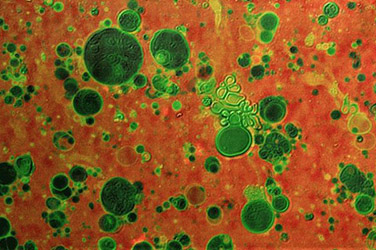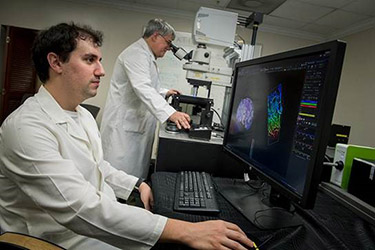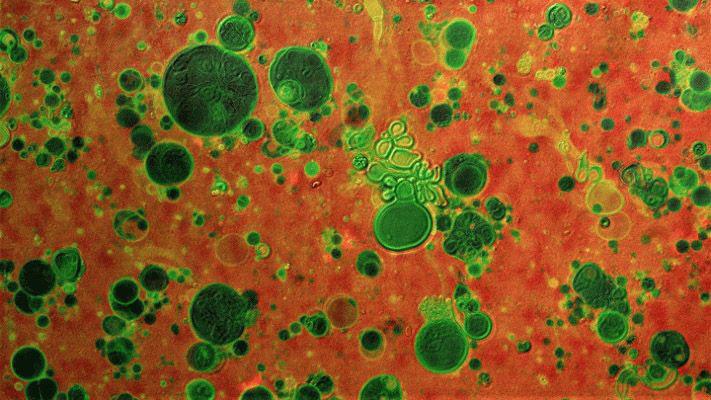Tracking Peptides in Cell Soup


If you think this soup looks unappealing for this year’s Thanksgiving feast, you’re right! If you were crazy enough to take a sip, you’d find it to be virtually flavorless—just a salty base (red) with greasy lipid globules (green) floating on top. But what this colorful concoction lacks in taste, it makes up for as a valuable screening tool for peptides, miniature versions of proteins that our bodies use to control many cellular processes.
In the second image, William Wimley, an NIH-supported researcher at Tulane University, New Orleans, has stirred up the soup and will soon add some peptides. These peptides aren’t made by our cells, though. They’re synthesized in the lab, allowing Wimley and team to tweak their chemical structures and hopefully create ones with therapeutic potential, particularly as smart-delivery systems to target cells with greater precision and deliver biological cargoes such as drugs [1].
Wimley wants to see which peptides have an affinity for water and which prefer lipids. How can he tell the difference? Dyes give the soup its color. Salty, water-loving, compartments soak up red dye, whereas compartments surrounded by greasy, waterproof membranes attract a lipid-loving substance linked to a green dye.
Using the soup, Wimley can choose the rarer peptides (labeled with a unique color to make them stand out) that are able to cross membranes to gain access to the watery cytoplasm, as well as look for those that target specific compartments inside the cell, such as the nucleus.
Wimley can then study the peptides further to see which types of cargo they can deliver to cells. He can also see which structures remain stable in the bloodstream and aren’t readily degraded by proteases, enzymes that break down unwelcome peptides, and which ones don’t toxically damage the cell membrane.
Right now, there are about 100 peptide drugs sold in the United States, Europe, and Japan [2]. Yet, few can deliver useful compounds to cells. Wimley is working hard to change that, since peptides have shown promise as therapies against some microbes, dubbed “superbugs,” that have developed resistance to multiple drugs and present a serious health threat, especially to people with weakened immune systems.
Finding the right peptide can be a real challenging process of elimination. But Wimley’s salty soup also provides plenty of colorful photo ops like this one, a finalist in the Biophysical Society’s 2018 Art of Science Image Contest.
References:
[1] Synthetic molecular evolution of hybrid cell penetrating peptides. Kauffman WB, Guha S, Wimley WC. Nat Commun. 2018 Jul 2;9(1):2568.
[2] Developing the Tools to Evaluate Complex Drug Products: Peptides (U.S. Food and Drug Administration)
Source: https://directorsblog.nih.gov/2018/11/15/tracking-peptides-in-cell-soup/

